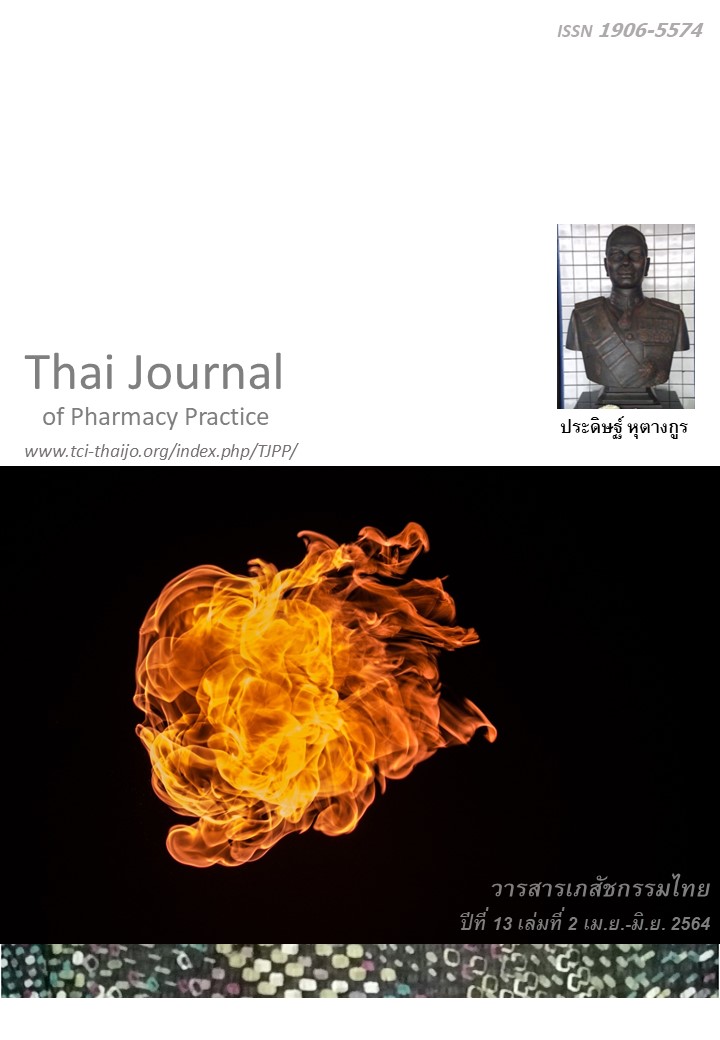การสำรวจความแตกฉานด้านสุขภาพของชาวไทยในภาคใต้ตอนล่าง
Main Article Content
บทคัดย่อ
วัตถุประสงค์: เพื่อสำรวจความแตกฉานด้านสุขภาพ (health literacy: HL) ของประชาชนในภาคใต้ตอนล่าง 7 จังหวัด ได้แก่ ยะลา ปัตตานี นราธิวาส สงขลา ตรัง สตูล และพัทลุง วิธีการ: การศึกษาเลือกตัวอย่างแบบหลายชั้น (multistage sampling) โดยเลือกเก็บข้อมูลจากอำเภอที่มีประชากรมากที่สุดในแต่ละจังหวัด การศึกษาแบ่งพื้นที่ของอำเภอเป็นเขตเทศบาลและนอกเขตเทศบาล ในแต่ละอำเภอ เลือกหนึ่งตำบลจากพื้นที่เขตเทศบาลและหนึ่งตำบลจากพื้นที่นอกเขตเทศบาลด้วยวิธีการสุ่มอย่างง่าย และเลือกหมู่บ้าน/ชุมชนมา 1 แห่งด้วยวิธีการสุ่มอย่างง่าย ต่อจากนั้น ผู้วิจัยใช้วิธีการเลือกครัวเรือนแบบตามสะดวกและเก็บข้อมูลจากตัวอย่าง 1 คนที่เลือกมาอย่างสุ่มต่อ 1 ครัวเรือน ขนาดตัวอย่างในแต่ละจังหวัดคำนวณตามสัดส่วนของประชากรในจังหวัดนั้น ๆ เครื่องมือที่ใช้ประเมิน HL คือ แบบวัดชนิดรายการคำที่มีคำถามทดสอบความเข้าใจ (THLA-W+) ผลการวิจัย: ผลการสำรวจในตัวอย่าง 1,310 คน พบคะแนนเฉลี่ยจากแบบวัด THLA-W+ เท่ากับ 34.65 ± 8.83 คะแนน (จากคะแนนเต็ม 48) โดยพบผู้ที่มี HL ไม่เพียงพอ (มีคะแนน THLA-W+ ≤37) คิดเป็นร้อยละ 56.49 ผู้ที่มีระดับการศึกษาชั้นมัธยมศึกษาปีที่ 1-3 ซึ่งใกล้เคียงกับระดับการศึกษาภาคบังคับ (มัธยมศึกษาชั้นปีที่ 3) มีคะแนนเฉลี่ยที่ 32.6±8.3 ผู้ที่มีการศึกษาที่สูงกว่ามีระดับ THLA-W+ ที่มากกว่า อายุที่มากขึ้นสัมพันธ์กับระดับ HL ที่น้อยกว่า การวิเคราะห์ความแปรปรวนพบปฏิสัมพันธ์ระหว่างการศึกษาและอายุอย่างมีนัยสำคัญทางสถิติ (F=2.34, df=12, 1290, P<0.001) สำหรับตัวอย่างในทุกกลุ่มอายุ ผู้ที่จบในระดับปวส.-ปริญญาตรีหรือสูงกว่า มี THLA-W+ สูงกว่าผู้ที่จบการศึกษาในระดับที่ต่ำกว่าอย่างมีนัยสำคัญทางสถิติ ยกเว้นในกลุ่มอายุ 60 ปีขึ้นไปที่การศึกษาระดับปวส.-ปริญญาตรีขึ้นไป มี HL มากกว่าเฉพาะกลุ่มประถมศึกษา ตัวอย่างกลุ่ม ปวส.-ปริญญาตรีหรือสูงกว่า มีค่าเฉลี่ยของ THLA-W+ มากกว่า 37 ในทุกกลุ่มอายุ ความเที่ยงของแบบวัด THLA-W+ อยู่ในเกณฑ์ที่ดี (Cronbach’s alpha = 0.92) สรุป: ประชาชนในภาคใต้ตอนล่างเกินครึ่งหนึ่งมี HL ไม่เพียงพอเมื่อประเมินด้วย THLA-W+ ดังนั้น คะแนนเฉลี่ยของ THLA-W+ ในกลุ่มอายุและการศึกษาต่าง ๆ สามารถใช้เป็นแนวทางให้กับหน่วยงานภาครัฐที่เกี่ยวข้องกับการคุ้มครองผู้บริโภคหรือภาคเอกชนในการจัดทำเอกสารและสื่อด้านสุขภาพให้เป็นที่เข้าใจแก่ประชาชนที่เป็นกลุ่มเป้าหมาย
Article Details
ผลการวิจัยและความคิดเห็นที่ปรากฏในบทความถือเป็นความคิดเห็นและอยู่ในความรับผิดชอบของผู้นิพนธ์ มิใช่ความเห็นหรือความรับผิดชอบของกองบรรณาธิการ หรือคณะเภสัชศาสตร์ มหาวิทยาลัยสงขลานครินทร์ ทั้งนี้ไม่รวมความผิดพลาดอันเกิดจากการพิมพ์ บทความที่ได้รับการเผยแพร่โดยวารสารเภสัชกรรมไทยถือเป็นสิทธิ์ของวารสารฯ
เอกสารอ้างอิง
World Health Organization. Regional Office for Europe. Health literacy: the solid facts [online]. 2013. [cited Nov 14, 2017]. Available from: apps.who.int/iris/handle/10665/326432.
Nutbeam D. The evolving concept of health literacy. Soc Sci Med 2008; 67: 2072-8.
Dewalt DA, Berkman ND, Sheridan S, Lohr KN, Pignone MP. Literacy and health outcomes: a systematic review of the literature. J Gen Intern Med 2004; 19: 1228-39.
DeWalt DA, Dilling MH, Rosenthal MS, Pignone MP. Low parental literacy is associated with worse asthma care measures in children. Ambul Pediatr 2007; 7: 25-31.
Baker DW, Parker RM, Williams MV, Clark WS. Health literacy and the risk of hospital admission. J Gen Intern Med 1998; 13: 791-8.
Sudore RL, Yaffe K, Satterfield S, Harris TB, Mehta KM, Simonsick EM, Newman AB, et al. Limited literacy and mortality in the elderly: the health, aging, and body composition study. J Gen Intern Med 2006; 21: 806-12.
Glassman P, National Network of Libraries of Medicine (NNLM). Culture in the context of health literacy [online]. 2003 [cited Dec 28, 2017]. Available from: nnlm.gov/outreach/consumer/hlthlit .html
Sørensen K, Pelikan JM, Röthlin F, Ganahl K, Slonska Z, Doyle G, Fullam J, et al. Health literacy in Europe: comparative results of the European health literacy survey (HLS-EU). Eur J Public Health 2015; 25: 1053-8.
Duong TV, Aringazina A, Baisunova G, Nurjanah, Pham TV, Pham KM, Truong TQ, et al. Measuring health literacy in Asia: Validation of the HLS-EU-Q47 survey tool in six Asian countries. J Epidemiol. 2017; 27: 80-6.
National Health Commission Office. Accelerate the development of networks to create Thai people 4.0 [online]. 2017 [cited Oct 20, 2019]. Available from: www.healthstation.in.th/action/viewarticle/1278/
Ministry of Public Health. 12th National Health Development Plan (B.E. 2560–2064). Bangkok: Ministry of Public Health; 2016.
Roma W. Creating health literacy in the community. In: Ministry of Public Health. Workshop for personnel development to reduce risk in non-communicable diseases by using communities as the base (CBI NCDs); 2018 Jan 16-17; TK. Palace Hotel and convention. Bangkok; 2018. p. 29.
Sørensen K, Pelikan JM, Röthlin F, Ganahl K, Slonska Z, Doyle G, Fullam J, et al;. Health literacy in Europe: comparative results of the European health literacy survey (HLS-EU). Eur J Public Health 2015; 25: 1053-8.
Mendenhall W. Ott L, Scheaffer RL. Elementary survey sampling. Belmont, CA: Wadsworth; 1971.
Janchooto P. Development of the Thai Health Literacy Assessment Using Word List with Extended Questions to Test Comprehension (THLA -W+): Testing in Sadao Hospital [independent study ]. Songkhla: Prince of Songkla University; 2017.
National Statistical Office Thailand. The 2010 population and housing census [online]. 2010 [cited Oct 20, 2019]. Available from: www.nso.go.th /sites/2014/Pages/pop/table-stat.aspx
Daraman N. Validation of the Thai Health Literacy Assessment Using Word List with Extended Questions to Test Comprehension in Muslim Patients [master thesis]. Songkhla: Prince of Song kla University; 2018.
Hayibueraheng H. Development of the Thai Health Literacy Assessment Using Word List with Extended Questions to Test Comprehension (THLA -W+): Testing in community [master thesis]. Song khla: Prince of Songkla University; 2018.


